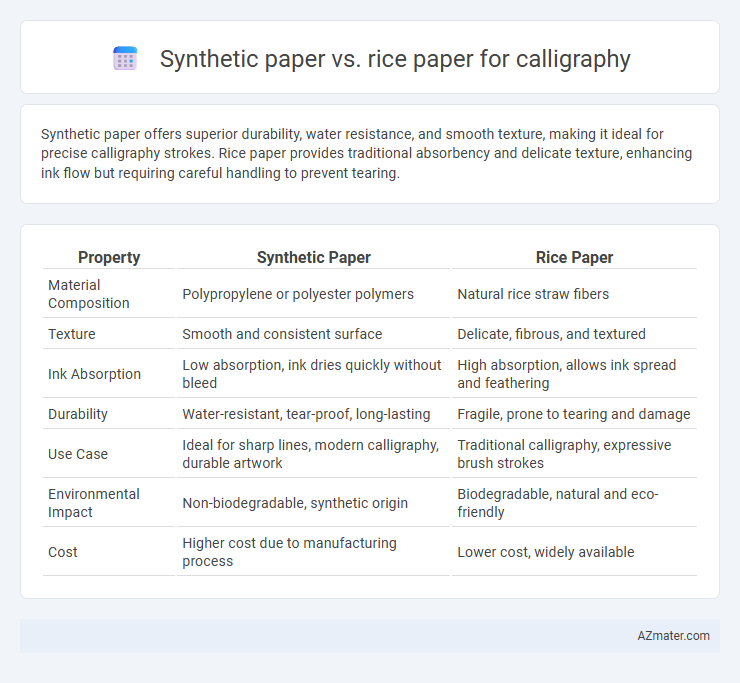Synthetic paper offers superior durability, water resistance, and smooth texture, making it ideal for precise calligraphy strokes. Rice paper provides traditional absorbency and delicate texture, enhancing ink flow but requiring careful handling to prevent tearing.
Table of Comparison
| Property | Synthetic Paper | Rice Paper |
|---|---|---|
| Material Composition | Polypropylene or polyester polymers | Natural rice straw fibers |
| Texture | Smooth and consistent surface | Delicate, fibrous, and textured |
| Ink Absorption | Low absorption, ink dries quickly without bleed | High absorption, allows ink spread and feathering |
| Durability | Water-resistant, tear-proof, long-lasting | Fragile, prone to tearing and damage |
| Use Case | Ideal for sharp lines, modern calligraphy, durable artwork | Traditional calligraphy, expressive brush strokes |
| Environmental Impact | Non-biodegradable, synthetic origin | Biodegradable, natural and eco-friendly |
| Cost | Higher cost due to manufacturing process | Lower cost, widely available |
Introduction to Calligraphy Paper Types
Synthetic paper offers durability, water resistance, and smooth surface ideal for modern calligraphy tools, enhancing ink flow and preventing bleed-through. Rice paper, traditional in East Asian calligraphy, features a delicate texture that absorbs ink uniquely, producing expressive strokes but requiring careful handling. Choosing between synthetic and rice paper depends on the desired aesthetic, ink type, and the artist's technique preferences.
What is Synthetic Paper?
Synthetic paper is a durable, water-resistant material made from synthetic polymers, offering a smooth surface ideal for calligraphy with ink or markers. Unlike rice paper, which is delicate and highly absorbent, synthetic paper resists tearing and wrinkling, providing consistent ink flow and vibrant color retention. Its non-porous texture allows for precise strokes and minimal bleeding, making it suitable for both beginners and professional calligraphers.
What is Rice Paper?
Rice paper, traditionally made from the pith of the Tetrapanax papyrifer plant, is prized in calligraphy for its delicate texture and ink absorption qualities that create smooth, fluid strokes. It offers high absorbency, allowing ink to spread naturally, which enhances the expressive brushwork characteristic of East Asian calligraphy. Unlike synthetic paper, rice paper is biodegradable and often preferred for its authentic feel and traditional aesthetic.
Texture and Surface Comparison
Synthetic paper offers a smooth, consistent surface ideal for crisp ink flow and precise brush control in calligraphy, while rice paper features a delicate, fibrous texture that absorbs ink more readily, creating natural variations in stroke intensity. The non-porous surface of synthetic paper prevents ink bleeding, resulting in sharp characters, whereas the porous nature of rice paper allows for dynamic expression but requires careful handling to avoid smudging. Artists seeking durability and repeatability often prefer synthetic paper, whereas those valuing traditional aesthetics and organic texture favor rice paper.
Ink Absorption and Flow
Synthetic paper offers superior ink absorption and consistent flow due to its smooth, non-porous surface that prevents ink bleeding and feathering. Rice paper, traditionally used for calligraphy, provides a delicate texture that absorbs ink quickly but may cause uneven flow and bleeding if the ink is too wet. The choice depends on the desired precision and style, with synthetic paper favoring controlled lines and rice paper supporting expressive, textured strokes.
Durability and Longevity
Synthetic paper offers superior durability and longevity compared to rice paper due to its water-resistant and tear-resistant properties, making it ideal for calligraphy works intended to last. Rice paper, though traditional and prized for its texture and absorbency, is more fragile and susceptible to yellowing, tearing, and damage from moisture over time. For calligraphy that requires preservation and frequent handling, synthetic paper ensures sustained quality and resilience.
Cost and Accessibility
Synthetic paper offers a more cost-effective and widely accessible option for calligraphy enthusiasts, with durable, smooth surfaces that withstand ink without bleeding. Rice paper, although prized for its traditional texture and absorbency, tends to be more expensive and less readily available, especially outside Asian markets. The choice between the two largely depends on budget constraints and the availability of materials in local markets.
Environmental Impact
Synthetic paper, made from plastic resins like polypropylene, offers durability and water resistance but poses environmental concerns due to its non-biodegradable nature and reliance on fossil fuels. Rice paper, traditionally crafted from natural fibers such as mulberry bark, is biodegradable and compostable, making it a more eco-friendly choice for calligraphy. The production of rice paper typically consumes less energy and generates fewer pollutants compared to synthetic alternatives, reducing overall environmental impact.
Suitability for Different Calligraphy Styles
Synthetic paper offers a smooth, durable surface ideal for bold, modern calligraphy styles such as brush lettering and marker-based techniques, providing consistent ink flow and preventing bleed-through. Rice paper excels in traditional East Asian calligraphy, particularly for styles requiring absorbent textures like sumi-e and Chinese brush calligraphy, where ink spreads naturally to create nuanced strokes. Selecting between synthetic and rice paper depends on the desired calligraphy effect, with synthetic favoring precision and rice paper enhancing expressive, fluid brushwork.
Choosing the Right Paper for Your Needs
Synthetic paper offers durability, water resistance, and smooth texture ideal for modern calligraphy techniques, while rice paper provides traditional absorbency and a delicate surface favored in East Asian calligraphy. Selecting the right paper depends on whether you prioritize longevity and ink control with synthetic options or the authentic brushstroke effect and natural fiber feel of rice paper. Evaluate ink type, brush style, and desired artwork longevity to determine the best paper for your calligraphy projects.

Infographic: Synthetic paper vs Rice paper for Calligraphy
 azmater.com
azmater.com